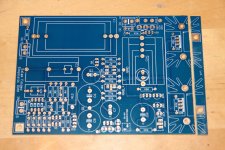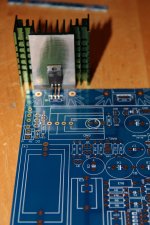When there is no heat being generated inside the casing, then Ta = Internal temperature (Tint).
And:
Delta Ta = Delta Tint
If there is any heat dissipation inside the casing, then Tint must be greater than Ta and that requires that delta Tint > Delta Ta
Any and all internal heat generators will INCREASE the variation in temperature of the coolest internal components.
Until the temperature stabilizes! Your assumption is based on a continuous rise in temperature. There comes a point where all will be evenly heated assuming a closed box.
You are wrong.Your assumption is based on a continuous rise in temperature.
My comment does not assume that there is a continuous rise in temperature.
My assumption is that increased internal dissipation increases Tint relative to Ta.
Show me why that assumption is wrong and I will change my comment appropriately.
The drift in parameters depend on delta Tint.
Why increase Tint if it only makes performance/drift worse?
Last edited:
What petities are you boys arguing about? Of course there is a continuous rise in temperature until it reaches equilibrium with the environment. After that just keep it environment protected so that it maintains that equilibrium. Opening a window or let the dog wave its tail nearby will of course alter the parameters...
Regards
Regards
Last edited:
BTW, has anyone tested the Mundorf Supreme silver-gold-oil at C3? I bought one 100nF for another project and thought about the simplistic so I ordered 2 of them.
Anyway, I'm gathering todoes for the next maintenance during fall.
For now I'm using Obbligato gold+ at C3 but I feel that the sound is to bright with C4's being Mundorf Supreme SIO's and loading is naked ones. Anyone tested the new Mundorf EVO SGO's on C3/C4?
Regards
Anyway, I'm gathering todoes for the next maintenance during fall.
For now I'm using Obbligato gold+ at C3 but I feel that the sound is to bright with C4's being Mundorf Supreme SIO's and loading is naked ones. Anyone tested the new Mundorf EVO SGO's on C3/C4?
Regards
Last edited:
My first folded build using Salas boards came home again and I decided to modd it a bit.
the simple mod consisted in changing output caps from obbligato gold to 4u7 Clarity cap MR and also putting some 4u7 Mundorf Mcap EVO alu oil on the shunt termination (where I had Sonicaps).
Talk about the "ultimate modd" ?? Incredibly, after some years building these simplistics I got the original thrills and spine shilling sensations.
This is quite a combination bringing a new level of detail and musicality to the scene.
No need for high currents and exotic shunts. I am really impressed by the results.
The EL cap bypassed vref allied to the slightly "soft but full bodied sound" of the termination caps can really bring the MR to sing.
Low cost high end this is.
the simple mod consisted in changing output caps from obbligato gold to 4u7 Clarity cap MR and also putting some 4u7 Mundorf Mcap EVO alu oil on the shunt termination (where I had Sonicaps).
Talk about the "ultimate modd" ?? Incredibly, after some years building these simplistics I got the original thrills and spine shilling sensations.
This is quite a combination bringing a new level of detail and musicality to the scene.
No need for high currents and exotic shunts. I am really impressed by the results.
The EL cap bypassed vref allied to the slightly "soft but full bodied sound" of the termination caps can really bring the MR to sing.
Low cost high end this is.
Its easier to concentrate on fine preferences when the board has solved the layout concerns. Those types are popular enough in the course of the FSP PCB builds. Its good when there is some basic subjective consensus about parts in a project. A rare thing.My first folded build using Salas boards came home again and I decided to modd it a bit.
the simple mod consisted in changing output caps from obbligato gold to 4u7 Clarity cap MR and also putting some 4u7 Mundorf Mcap EVO alu oil on the shunt termination (where I had Sonicaps).
Talk about the "ultimate modd" ?? Incredibly, after some years building these simplistics I got the original thrills and spine shilling sensations.
This is quite a combination bringing a new level of detail and musicality to the scene.
No need for high currents and exotic shunts. I am really impressed by the results.
The EL cap bypassed vref allied to the slightly "soft but full bodied sound" of the termination caps can really bring the MR to sing.
Low cost high end this is.
4u7 Mundorf Mcap EVO alu oil on the shunt termination (where I had Sonicaps).
Is this in the PSU, R5x? Can you really proclaim hering differences here? It has an 1,2 resistor in front of it putting its own ESR out of league.
R14 47k PRP 1WIts easier to concentrate on fine preferences when the board has solved the layout concerns. Those types are popular enough in the course of the FSP PCB builds. Its good when there is some basic subjective consensus about parts in a project. A rare thing.There was specific layout provision for EVO size in C2x also. What you combined for interstage (C3)? What resistors for Rload and R14?
Load Vishay metal foil trimmer
I placed Mundorf Mcap EVO alu-oil in C2x from the beginning. So, I have no compare impression for other type of caps in that spot. My concern is about C3 (0.1uF) and C4 (2.2uF) . I used Mundorf SIO for both. Have you tried to compare these to ClarityCap MR series? Any other members opinions are welcome.
ESR is only one parameter in capacitors. At that position its already impaired indeed.
I have great respect for quality components where it its proper but I also think that it shows greateness when not chooosing expensive components on places where their fortunes not comes to any good. Just trowing expensive comps everywhere might look a little over tops to me.
It can be so that one cap makes differences to another, even here, I dont know, but maybe one is good with just a dime lyt or tant.
Im away for a while now so there is no progress for me to test atm unfortunately.
I placed Mundorf Mcap EVO alu-oil in C2x from the beginning. So, I have no compare impression for other type of caps in that spot. My concern is about C3 (0.1uF) and C4 (2.2uF) . I used Mundorf SIO for both. Have you tried to compare these to ClarityCap MR series? Any other members opinions are welcome.
My first build used SIO. I could live with it without any regret. Trying other caps is just a function of my diy disease, and in the end, I only expect to find a different flavor of ice cream. 85-90% of the sound comes from the topology and implementation, assuming solid parts use. Beyond that, it is more about system synergy and personal taste. Unfortunately, trial and error is all you have left at this point.
Be careful not to chase the rabbit too much....said the kettle to the pot.
I have great respect for quality components where it its proper but I also think that it shows greateness when not chooosing expensive components on places where their fortunes not comes to any good. Just trowing expensive comps everywhere might look a little over tops to me.
It can be so that one cap makes differences to another, even here, I dont know, but maybe one is good with just a dime lyt or tant.
Im away for a while now so there is no progress for me to test atm unfortunately.
It also has layout provision for electrolytic termination. EVO Alu is 5 EUR and EVO Alu oil is 9,5 EUR. A rather economic caps range.
My first build used SIO. I could live with it without any regret. Trying other caps is just a function of my diy disease, and in the end, I only expect to find a different flavor of ice cream. 85-90% of the sound comes from the topology and implementation, assuming solid parts use. Beyond that, it is more about system synergy and personal taste. Unfortunately, trial and error is all you have left at this point.
Be careful not to chase the rabbit too much....said the kettle to the pot.
I definitely can "live" with my Mundorfs and FSP sounds amazing. It was my natural curiosity.... I just tried to see if someone had big change and different impressions by testing Mundorfs SIO vs. some other brands.
In addition, my biggest challenge is to set the correct Bios. I have 1.8V P2P. It is like 0.9V below and 0.9V above 3.6V set point. It is stable for second or two and then my voltage getting up or down to these low and high points. It is still dancing even after 3 hours of operation when all components are "stable-hot". How to stabilize it? I tried to set 3.6V exactly in the meddle of that range, but it might be other way to decrease such fluctuations in regulator.
Last edited:
Are you seeing that in a closed case? I found a slow steady climb in a closed case (with meter leads clipped in place and coming out of the case), but as soon as I opened the case to adjust the TP1-TP2 voltage would drop like a stone, then I had to wait maybe 30 minutes to see what effect my change made. I think that is the biggest challenge in high gain versions, especially for us obsessive types 
- Home
- Source & Line
- Analogue Source
- Simplistic NJFET RIAA

